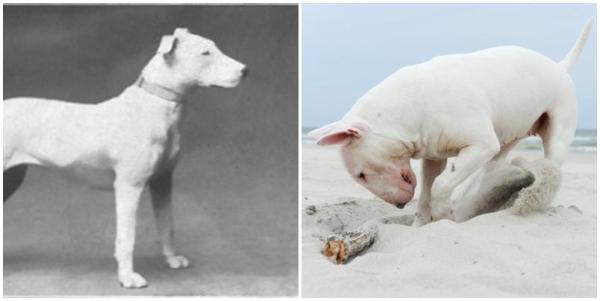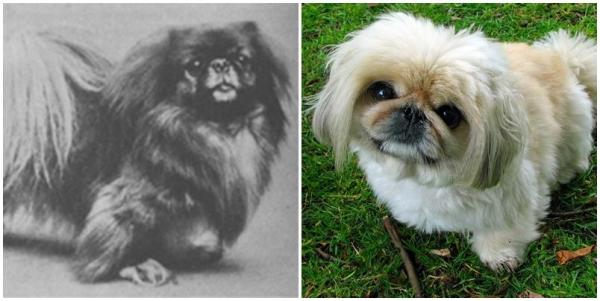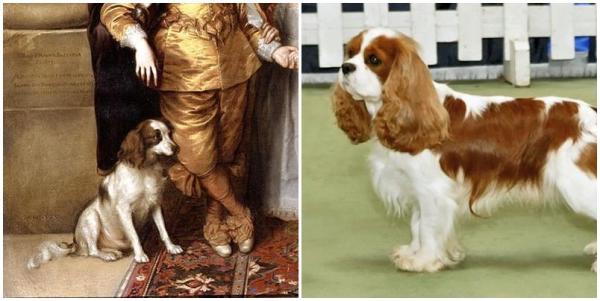Popular Dog Breeds Before and After



See files for Dogs
To know what physical changes have occurred in dog breeds over the last 100 years or so, then we have to go back to 1873. This is when the Kennel Club was founded. This British breeders club was designed, in part, to standardize the morphology (the study of physical shape and form) of dog breeds for the first time. However, there are also older works of art which depict certain dog breeds at certain times.
In this AnimalWised article, we are going to show you before and after pictures of dog breeds. In doing so, we will show you the changes these breeds have gone through and the similarities which have remained. We also go into some of the health issues related to pedigree breeding and help explain why the domestic dog is the only species with such a varied morphology. Discover 20 of these popular dog breeds before and after breeding has changed them, you might be quite surprised.
- Pug
- Scottish Terrier
- Bernese Mountain Dog
- Old English Sheepdog or bob-tailed sheepdog
- Bedlington Terrier
- Bloodhound
- English Bull Terrier
- Poodle
- Doberman Pinscher
- Boxer
- Wire Hair Fox Terrier
- German Shepherd
- Pekingese
- English Bulldog
- Cavalier King Charles Spaniel
- St. Bernard
- Shar Pei
- Schnauzer
- West Highland White Terrier
- English Setter
- Why do these breeds suffer from such health problems?
1. Pug
In the painting on the left we see a Pug named ‘Trump’, a pet of the artist William Hogarth which he painted in 1745. At the time the breed was not standardized, but it was well-known and fairly popular. As we can see, the dog does not have the same squashed snout as modern day pugs and the legs are proportionately much longer. While there may be issues with perspective when viewed in a painting, we can estimate that the older Pug was bigger in stature. They both, however, seem to have an elongated tongue which can be seen in both pictures.
Currently the Pug suffers from numerous health issues related to their morphology. Their longer palate seriously restricts airways resulting in the coarse breathing expected of these animals, they suffer entropion which causes their eyes to bulge and patellar luxation which can result in dislocated knees. They are also prone to epilepsy and Legg-Calvé-Perthes disease, latter of which restricts blood flow to the bones and can cause necrosis. It is often very painful. They are susceptible to heat stroke and even regular food can be a choking hazard. The selective breeding which has taken part in the interim of these before and after pictures is not something which seems to benefit the dog, only the aesthetic taste of their human guardians.

2. Scottish Terrier
According to pictorial evidence, the Scottish Terrier has undoubtedly gone through one of the most drastic changes in terms of morphology. We can see in the recent photograph that the head is much more elongated and there has been a considerable shortening of the legs. The previous picture dates back to 1859.
Unfortunately, these breeds are susceptible to different types of cancer (bladder, intestinal, stomach, skin and breast) as well as being susceptible to von Willebrand disease which causes spinal problems and abnormal breeding. They are also prone to suffer spinal problems. None of this stops them from being a feisty, playful and very loving, if not a little stubborn.

3. Bernese Mountain Dog
In the painted image on the left we see a family of Burmese Mountain dogs painted in 1862 by artist Benno Rafael Adam. He was a major animal painter of the 19th century. In this realistic painting we can observe a cattle dog with much less pronounced cranial markings and with a rounder head. However, the distinctions are not as stark as some of the other dogs on this list.
They often suffer from diseases such as dysplasia (both the elbow and the hip), histiocytosis, osteochondritis dissecans (another type of joint disorder) and is also susceptible to gastric torsion. This last condition is fatal if untreated.

4. Old English Sheepdog or bob-tailed sheepdog
The first photographic example on our before and after dog breeds list, this one was taken in 1915. As you can see, a lot has changed since then and the current standard. One of the main observations is the difference in coat, with the current breed morphology being much longer. The shape of the ears and the cranial shape have also changed significantly.
Their coat is one of the biggest factors to influence their health as it makes them susceptible to otitis, allergies and parasitic infestations. They are also affected by hip dysplasia and other diseases related to joints and mobility.

5. Bedlington Terrier
The Bedlington Terrier's physical appearance is one of the most interesting. They resemble a sheep in both their curly white coat and head shape. This is not a coincidence as breeders have attempted to create this look and show dogs are clipped to give them an even greater roundness. As you can see, the difference between the pictures is staggering and they almost don't look like they are at all related.
They are susceptible to various diseases such as heart murmurs, epiphora, retinal dysplasia, cataracts and a high incidence of kidney and liver problems.

6. Bloodhound
It's almost shocking to see the differences in the Bloodhound 100 years ago and its current form. As we can see, their wrinkles have been greatly enhanced and are now one of the distinguishing features of the breed. The ears are also much longer today than before.
This breed has a high rate of gastrointestinal ailments and skin problems, as well as many ear and eye problems. The average mortality rate of the Bloodhound is lesser than many other dogs at between 8 and 12 years of age.

7. English Bull Terrier
The English Bull Terrier is undoubtedly one of the most popular current breeds whether we are talking about the standard sized dog or the miniature breed. Their morphology has changed radically, as is depicted in the photograph from 1915 (that black and white on on the left) compared to now. A deformation of the skull has taken place creating a sloped head shape and their musculature has been greatly increased.
The Bull Terrier has a particular predisposition towards skin problems as well as issue with the heart, kidney, deafness and patellar dislocation. They are also more likely to develop eye problems.

8. Poodle
While in present day there are different physical variations of the Poodle breed, we can see a drastic change in these before and after breed pictures. They are very popular, but their physical appearance can often belie their intelligence. The changes as we can see have a lot to do with the size and texture of their coat, although it is difficult to see skeletal changes in these pictures.
They are susceptible to epilepsy, gastric torsion, Addison's Disease, cataracts and dysplasia, especially in larger specimens.

9. Doberman Pinscher
In the 1915 image of the Doberman Pinscher we can see their coat is thicker and not as sleek. They also have a noticeably shorter snout. The current standard is much more stylized. However, this desire for a specific look also leads to the unfortunately common practice of tail docking.
They are prone to suffer spinal problems, gastric torsion, hip dysplasia and heart problems. They can also experience Wobbler syndrome which results in a neurological deficit and related disabilities. This is more frequent in females than in males.

10. Boxer
Another very popular dog, the Boxer has undergone a huge transformation since their early days. In this photograph we see an image of ‘Flocky’, the first registered Boxer of which we still have evidence. Although it is difficult to see from the image, the shape of the jaw has been greatly modified as well as the lower much more dropped ears.
The Boxer is susceptible to suffer from all types of cancer as well as heart problems. They also have a tendency toward gastric torsion. Due to their shortened snout (another significant change), they can suffer from breathing problems and dizziness in the heat. Allergies are also common in this breed.

11. Wire Hair Fox Terrier
It is curious to observe this 1886 portrait of a Wire Hair Fox Terrier. Unlike today it has much less curly hair, has an elongated snout and almost completely different body comportment.
Although the incidence of health problems is not as great as those in breeds like the Boxer, they are likely to suffer from epilepsy, deafness, thyroid problems and digestive dysfunctions among others.

12. German Shepherd
The German Shepherd is one of the most exhibited breeds in dog shows across the world. While there different subdivisions of the German Shepherd breed, they can essentially be broken down to two variations: show dogs and working dogs. The first more clearly resembles the before picture from 1909 we see below.
Currently their main health problems include hip and elbow dysplasia, digestive issues and ocular problems. The more current photograph is of a dog which one a dog show in 2016. There is a lot of controversy over the practice of breeding dogs to have the sloped back as depicted. In a few years it is probable this dog will not be able to walk thanks to their spinal deformation. Despite this, the current breed standard still encourages this destructive look.

13. Pekingese
The Pekingese is one of the most popular Chinese breeds of dog. At different points in their history they were considered sacred animals and were common companions to royalty. As with the previous breeds, we can see important morphological change. They now have a more flattened snout, more rounded head and the nasal passages are more restricted.
Although it may not seem so different from the before and after pictures, they have continued to develop greater health problems such as breathing difficulty (due to stenotic nares and an elongated soft palate), various eye problems (trichiasis, cataracts or progressive retinal atrophy) and mobility issues. The latter is mainly due to patellar dislocation or slipped vertebrae.

14. English Bulldog
The English Bulldog has undergone a radical change, perhaps more than other breeds on this list. We can see, in particular, how the structure of the skull has bee deformed since 1790 and today. Also, their body has now been given a plumper yet more muscular frame.
It is probably one of the breeds with one of the most inherited genetic problems. They have difficult breathing, predispositions towards gastric torsion and eye problems, as well as being prone to obesity.

15. Cavalier King Charles Spaniel
The Cavalier King Charles Spaniel is one of the most popular dogs in the United Kingdom. They derive the name from the subject of the portrait on the left, King Charles II, as he poses with his favorite dog. This is also where the breed derives their name. This breed was an exclusive dog to nobility and ladies of the court used to put them under their skirts so as to help keep them warm in winter. The Cavalier King Charles Spaniel was one of the first breeds to achieve a specific and desired morphology based simply on their appearance as opposed to their usefulness.
Veterinary surgeon William Youatt was one of the first critics of this breed, stating in 1845:
The King Charles’s breed of the present day is materially altered for the worse. The muzzle is almost as short, and the forehead as ugly and prominent as the veriest bull-dog. The eye is increased to double its former size, and has an expression of stupidity with which the character of the dog too accurately corresponds
Dr. Youatt was not misguided in his view. This breed is now prone to suffer many diseases such as the hereditary disease syringomyelia which can be tremendously painful. They are also susceptible to prolapse of the mitral valve, heart failure, retinal dysplasia or cataracts. In fact, 50% of dogs of this breed die of heart problems and the last cause of death is old age.

16. St. Bernard
The St. Bernard is one of the most famous large dogs, perhaps due to the popularity of 1990s comedy Beethoven. In the photograph on the left, we can see a less thick dog with a smaller head and much less marked features.#
Genetic selection through breeding has made them prone to dilated cardiomyopathy as well as dyslasia and obesity. They are also susceptible to heat stroke and gastric torsion which is why they are not to be over exercised.

17. Shar Pei
The Shar Pei is an easily recognized dog today, but you would be forgiven if you didn't recognize them from the before picture below. As with the Bull Terrier, the exaggeration of certain physical features has made the breed prone to many health problems. They are well known by their wrinkles, giving them an unmistakable appearance, but also malaise and various ailments.
They are susceptible to all kinds of skin problems, but also have eyes difficulties related to their wrinkles. They can also suffer from a breed specific disease known as Shar Pei fever and often present with food allergies.

18. Schnauzer
The Schnauzer presents in three different types: miniature, standard and giant. We can see a lot has changed since 1915 when the photograph was taken. The body is more compacted, but the snout is longer and the characteristics of the coat, like their beard, are more accentuated.
They are prone to suffering the Schnauzer comedo syndrome which presents as a type of dermatitis that often affects the digestion of the animal resulting in allergies. They also experience pulmonary stenosis and vision problems, sometimes related to the length of their eyebrows.

19. West Highland White Terrier
The West Highland White Terrier is commonly known as a Westie, is originally from Scotland. Although they were formerly known as dogs used for fox and badger hunting, they are now more known for being companion animals.
In the 1899 picture we can see two specimens which are quite different from the current breed standard. They didn't have a coat which is as dense as it is now and their body shape is quite different.
They often suffer from craniomandibular osteopathy with abnormal growth of the jaw as well as leukodystrophy, Legg-Calvé-Perthes disease, toxicosis or patellar dislocation.

20. English Setter
In the English Setter we can clearly observe the exaggeration of certain characteristics between 1902 when the first picture was taken and now. Their snout has been significantly elongated, their necks have been stretched out and they have a long frill of hair on their chest, legs, abdomen and tail.
Like all the aforementioned breeds, they are susceptible to various diseases such as allergies, elbow dysplasia, hypothyroidism and other types of allergy. Their life expectancy is between 11 and 12 years.

Why do these breeds suffer from such health problems?
Specific breed dogs, especially those considered pedigree dogs, have been crossed for generations between siblings, parents and children, and even grandparents and grandchildren. The latter is not currently a usual or ‘desirable’ practice, but it does happen and even some respected breeders take part in it. The reason for doing so is simple: breeders wish to seek to enhance the attributes of a certain breed and try to ensure they are continued in the lineage by producing puppies with these characteristics.
The consequences of inbreeding are evident, especially in the social rejection of people who take part in it. In Ancient Egypt, it specifically in the 18th Dynasty, it was shown that royals who took part in this practice were more susceptible to perpetrate hereditary diseases, aggravate existing hereditary diseases, cause infertility and increase mortality[1].
As we have said, not all breeders carry out these inbreeding practices, but they are still all too common. For this reason it is highly recommended to be properly informed before adopting a dog into our home, especially if we choose to go to a breeder rather than adopting from a shelter.

If you want to read similar articles to Popular Dog Breeds Before and After, we recommend you visit our Facts about the animal kingdom category.
1 Information from the BBC documentary Pedigree Dogs Exposed has been used.


























